Method for clustering wireless sensor network based on energy consumption balance
A wireless sensor and energy balance technology, applied in network topology, wireless communication, energy consumption reduction, etc., can solve the problem of incomplete connectivity of the network, uneven distribution of nodes, and unreasonable planning of cluster head node density and the number of ordinary nodes, etc. question
- Summary
- Abstract
- Description
- Claims
- Application Information
AI Technical Summary
Problems solved by technology
Method used
Image
Examples
Embodiment Construction
[0026] Relevant technical content and detailed description of the present invention, now cooperate accompanying drawing to illustrate as follows: figure 1 It is a flowchart of the realization process of the present invention.
[0027] 1. Cluster establishment phase
[0028] First, the nodes are evenly distributed in a certain geographical area, the energy of each node is detected, and a cluster head energy threshold β is set, and the nodes higher than the cluster head energy threshold β are considered as cluster head nodes. After the cluster head node is determined, each cluster head node selects the mid-perpendicular line of the cluster head node closest to itself as the radius to form multiple tangent circles among the adjacent cluster head nodes, and the range of each circle is the cluster head node. The range of the cluster the node is in. It can be simply proved that no matter what the topological structure is, the nodes closer to the sink node must bear more data sendi...
PUM
 Login to View More
Login to View More Abstract
Description
Claims
Application Information
 Login to View More
Login to View More - R&D
- Intellectual Property
- Life Sciences
- Materials
- Tech Scout
- Unparalleled Data Quality
- Higher Quality Content
- 60% Fewer Hallucinations
Browse by: Latest US Patents, China's latest patents, Technical Efficacy Thesaurus, Application Domain, Technology Topic, Popular Technical Reports.
© 2025 PatSnap. All rights reserved.Legal|Privacy policy|Modern Slavery Act Transparency Statement|Sitemap|About US| Contact US: help@patsnap.com



